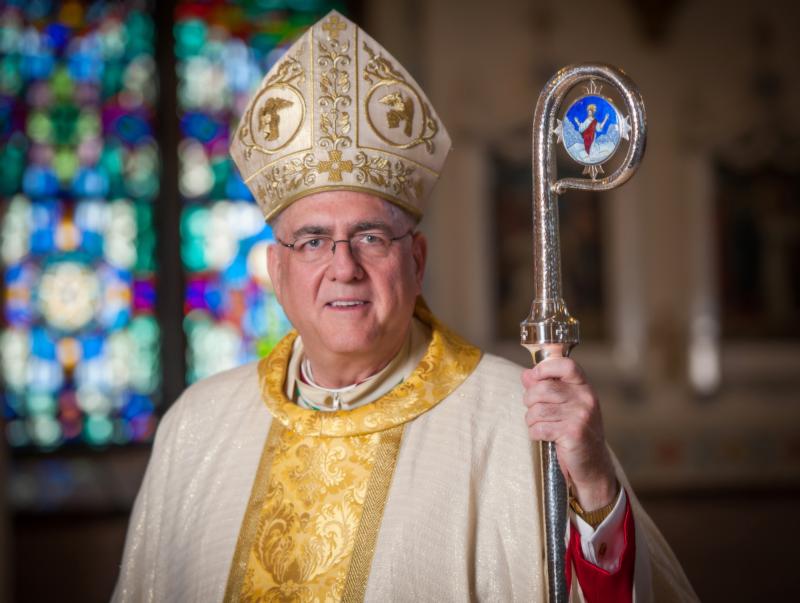
by Archbishop Joseph F. Naumann
Parish pastoral visits are one of the aspects of my ministry as bishop that I enjoy the most. Our parishes have much in common, but each has a unique personality.
In recent weeks, I visited: 1) Most Pure Heart of Mary Parish in Topeka, which boasts one of our best programs for the care of elderly and shut-ins as well as a magnificent youth choir; 2) Holy Spirit Parish in Overland Park, which has a well-developed program for high school youth and sent one of the largest delegations to the “Enflame Our Hearts” convocation; 3) St. Gregory Parish in Marysville, which enjoys its magnificent new church and the opportunity it provides to welcome many Catholic and non-Catholic visitors; 4) Good Shepherd Parish in Shawnee, which has developed a vibrant Hispanic ministry and is proud of its 26-year relationship with its sister parish, El Buen Pastor (Good Shepherd) in El Salvador; and 5) St. Joseph Parish in Shawnee, which has been able constantly to renew itself because of the age diversity of its community as evidenced by many baptisms, first Communions, marriages and funerals. St. Joseph recently renovated its church and added a large and gracious vestibule where parishioners can gather before and after Mass.
This past Saturday, I visited St, John the Baptist and Holy Family parishes on Strawberry Hill in Kansas City, Kansas. These parishes share a pastor, Father Peter Jaramillo, who is also pastor for St. Mary-St. Anthony Parish in downtown Kansas City.
Holy Family Parish was founded to serve the Slovenian Catholic community. The parish was shepherded for decades by Msgr. Heliodore Mejak, who remains a legend within the community.
Readers of The Leaven are in debt to St. John the Baptist, because it is the community that helped form in the faith our editor, Father Mark Goldasich. They also have welcomed in recent years members of the young and growing Burmese Catholic community that has brought a new vitality to the parish.
During my meeting with parish leaders, we were all moved by the testimonies of members of the Burmese community, who described the harsh religious persecution that forced them to flee their homeland.
Old-time members of Holy Family and St. John’s took note of the parallels between the experience of their Slovenian and Croatian ancestors with current refugees from Myanmar, formerly known as Burma.
I enjoyed celebrating Mass in the beautiful church of St. John the Baptist and was inspired by the music that included hymns in Croatian, Burmese and English.
My visit happened to coincide with the monthly liturgy that features the parish youth serving as lectors, gift-bearers and eucharistic ministers.
My meeting with leaders from both parishes took place in the “Tea Room” that is part of the Strawberry Hill Museum, a former orphanage.
After the meeting, I visited the parish bowling alley operated by the Men’s Club. It was packed with bowling enthusiasts. I was also escorted to the parish hall, where there was live music, as well as traditional Croatian Christmas folk dancing.
The previous week the parish hall hosted a Christmas movie that attracted youth both from the parishes as well as non-Catholic children from the neighborhoods.
It was impressive to witness the vitality of this Catholic community in this very historic part of Kansas City, Kansas. The Strawberry Hill Museum features rooms with exhibits of the diverse ethnic communities that at one time considered Strawberry Hill their home.
It was inspiring to witness the beauty of these multiple cultures with their unique languages, ethnic foods, music, dances, art, literature, drama and traditions. However, they all shared in common what is most important — a deep and profound love for Jesus and his church.
Pope St. John Paul often wrote about the importance of culture. Our late Holy Father was convinced from his Polish experience that culture is more important than politics. Governments come and go, but the culture transmits from one generation to the next the faith and values of their ancestors.
Poland was eliminated from the map of Europe for decades, but the people maintained their history and identity through their culture. The future pope during the Nazi occupation of Poland performed in the Rhapsodic Theatre, an underground resistance group that was committed to preserving the rich cultural heritage of Poland.
Christmas is an important time for families. Many families have beautiful traditions that include special foods, music and rituals for Christmas. These are extremely important for developing deep, authentic bonds that span generations.
However, it is most important that we not forget why we have these traditions and rituals for Christmas. With the rich diversity of all our ethnic heritages, the core of what we celebrate is universal and unique for Christians.
Our celebration commemorates the most important moment in human history, when the Creator of the cosmos, the Lord of Lords and the King of Kings chose to immerse himself in our humanity so that we could share in his divinity.
In a secular culture that wants to strip Christ from Christmas, we must be very intentional in making certain that our youth know why we give gifts, why we enjoy special foods and why we have festive decorations.
Make participating in the celebration of Mass the most important tradition in your family observance of Christmas. However, also make certain that awe for the miracle of God embracing our humanity, faith in the love and mercy of God revealed in one born in Bethlehem, and prayer — the ability to communicate and develop a friendship with Jesus — are the central elements of your family Christmas celebrations.
Preserve and renew your family Christmas traditions, but also be not afraid to begin new traditions that make Jesus the center of Christmas in your home.

